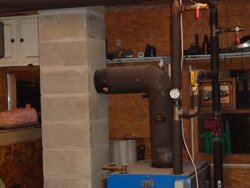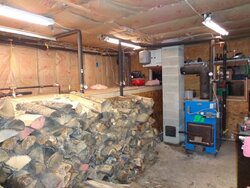i dont have a gasser or the most popular choice in boiler by any means but am looking for some direction with my frustrations. i have a 1000 gallons of storage, boiler charges storage, loads pull from storage. my circ is hook on return side after danfoss valve to limit return temp to 140 deg.. after 2 weeks of the boiler running i am getting frustrated with my storage temps. i seem to have a hard time to push it to 150 deg. boiler output only 145-160 and staying on the lower side for the most part. i figured with the danfoss installed i would be able to push higher outlet temps with return water being hotter. 3 spd pump on low and even tried throttling with ball valve. it helps but not seeing anywhere the results i am hoping for.
any thoughts, hopefully the pics will give a bit of insight on my plumbing
any thoughts, hopefully the pics will give a bit of insight on my plumbing




